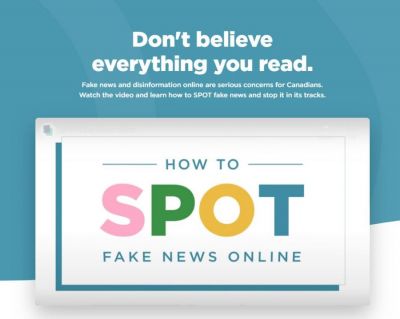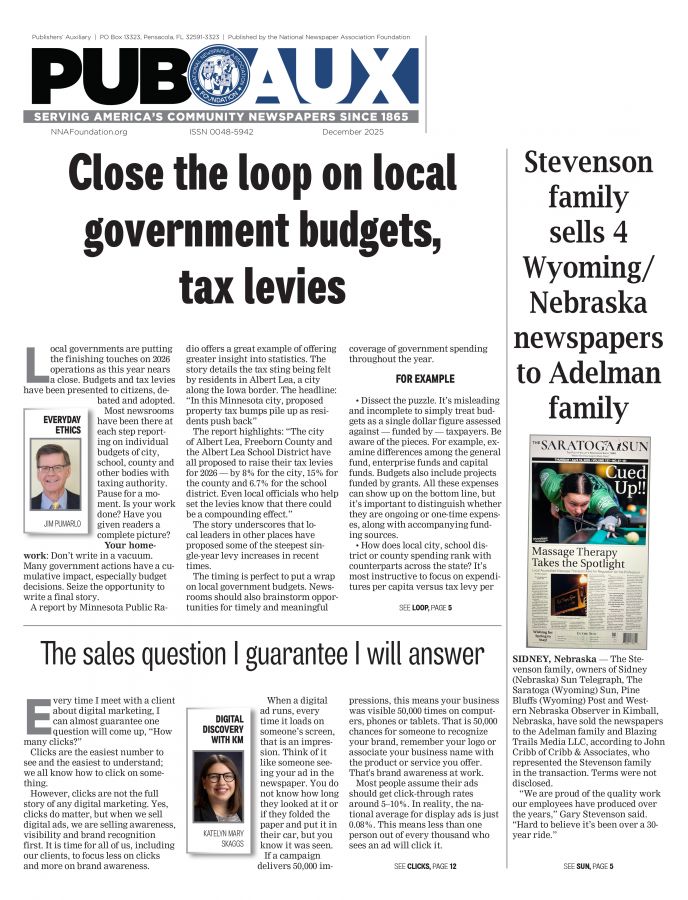Oh, Canada, we cheer your SPOT fake news campaign
Tom Silvestri
Nov 3, 2020
Canada promotes a campaign to help readers spot fake news online and it surpassed expectations during the first year of rooting out evil.
Is that real or fake news?
Time’s up.
Real!
See for yourself at www.spotfakenews.ca
Newspaper Association Managers President Steve Nixon, executive director of the Saskatchewan Weekly Newspapers Association, mentioned the Canadian effort on our Relevance Project call this week and I was impressed by the site’s clear message on how everyone can spot fake news and, more importantly, stop it.
The drill, according to its creators, is to ask four questions when you SPOT or suspect questionable news and information online:
S: Is this a credible Source? Check the source of the article and be skeptical.
P: Is the Perspective biased? Think critically and look for varying viewpoints on an issue.
O: Are Other sources reporting the same story? Be your own fact-checker and verify the validity of the story.
T: Is the story Timely? Check the date the story was published. “Sometimes, stories use old information to take advantage of a timely occurrence.”
I asked the campaign’s organizer, News Media Canada, what’s been the result of the media literacy tool. Director of Marketing and Research Kelly Levson responded quickly with an overview as well as with details on how the campaign performed against its target goals.
“We originally launched SPOT in advance of the 2019 federal election amidst growing concern over disinformation and fake news being spread online,” Levson told me in an email.
“We developed an animated video that outlines the four simple steps that spell out SPOT. To communicate the details of the simple media literacy tool the program was supported by an ad campaign in Canadian newspapers as well as a paid YouTube campaign.”
Levson added the program was financed in part by the Canadian government — hear that, Congress! — and “we had some clear deliverables to achieve as part of our agreement.”
The accompanying results are as of March:
Target: 150,000 video views within six months of launch.
Delivered: 250,487 video views (as of Nov. 30, 2019); 395,865 views (by March 16) six months after launch.
Target: 250 participating newspapers in launch/small-space print ad campaign.
Delivered: 375 participating newspapers (daily/community).
Target: 300 downloads of member toolkit and creative material within six months of project start.
Delivered: 506 full page launch ad downloads.
Target: MRP rating of 2 million to 4 million impressions (exposures) nationally.
Delivered: 5,957,299 impressions (reach) from national media coverage (MRP), plus 7,642,000 reach from the press release. Total coverage reach of 13,569,299.
“The site and the video continue to live on and we have plans to make some minor updates to the site copy to reflect the current pandemic,” Levson added.
When it launched the campaign, News Media Canada focused on addressing an alarming statistic about fake news.
“We know that so-called fake news, and the spread of disinformation online are very real concerns for Canadians,” said John Hinds, President and CEO of News Media Canada. “According to an Ipsos-Reid study, 63% of Canadians have trouble distinguishing between legitimate news websites and fake news stories. We developed ‘SPOT’ to provide Canadians with a simple, easy-to-remember tool they can use anytime they’re consuming news online.”
American press associations can learn from the Canadian program, and amplify it based on the needs of its member newspaper. This week, for example, the Pennsylvania NewsMedia Association released to its members an article on how to identify fake news.
The SPOT campaign also fits the Relevance Project’s advocacy for using the Community Forum strategy to advance media literacy.
In its material, News Media Canada describes itself as an “advocate in public policy for daily and community media outlets and contributes to the ongoing evolution of the news media industry by raising awareness and promoting the benefits of news media across all platforms.”
As we close in on Election Day, Hinds’ words also resonated with many of us who advocate for trusted journalism produced by community newspapers.
“The term fake news is often used incorrectly, to discredit or dismiss information that people don’t like or agree with,” Hinds said in his statement.
“SPOT Fake News Online is intended to help build citizens’ critical thinking and preparedness and increase their resiliency to disinformation.”
Spot-on.
Tom Silvestri, most recently president and publisher of the Richmond (Virginia) Times-Dispatch, is the executive director of the Relevance Project, the joint effort of the Newspaper Association Managers strengthen the industry’s unique role as the provider of quality journalism and the keeper of public forums for thousands of communities across the continent. NAM is a group of state, regional and national press associations across the U.S. and Canada.












